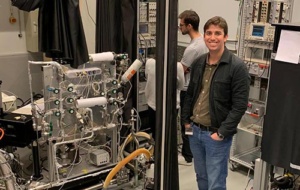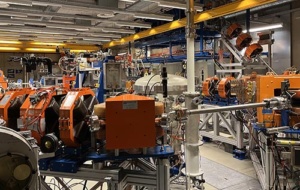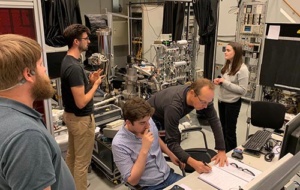Beamtime at FELIX Laboratory

Philip standing by the experimental setup at FELIX used to produce and study the metal clusters.
Old Members’ Trust Graduate Conference and Academic Travel Fund Report – Philip Pearcy (2020, DPhil Physical and Theoretical Chemistry)
Recently, I was able to travel to the FELIX Laboratory in The Netherlands with my colleagues in the Mackenzie Group in order to perform experiments on gas-phase metal clusters thanks to funding from the University College Old Members’ Trust travel fund. In May, our group was successful in acquiring time to study metal clusters with our collaborator Dr. Joost Bakker using the free electron laser setup at FELIX. We applied to use this high intensity infrared laser system as it would allow our group to study how molecules bind to metal clusters in greater detail than can be achieved in our laboratory in Oxford. We have an interest in studying these clusters as they can be used to emulate metallic catalysts, which have important application across a range of industrial processes. We wanted to understand how molecules bind to clusters by studying how the molecules absorb infrared radiation, so being able to use the FELIX laser which scans across a wide range of wavelengths was very beneficial to our group.

The FELIX laser system, consisting of multiple linear accelerators used to accelerate electrons to produce the high intensity infrared laser pulses.
Our group studied metal clusters of different elements and sizes with nitric oxide molecules. Nitric oxide is a known pollutant from combustion processes, so it is useful to understand how it can be removed using metal surfaces and clusters. We began by studying tantalum clusters. We discovered that the clusters themselves were very effective at absorbing infrared light. This had not been predicted by our initial calculations, so we found this very interesting and it led to us expanding our study to understand this behaviour. Following this, we moved onto studying cobalt clusters with nitric oxide. We chose cobalt as we have previously studied this metal in our laboratory, so we could compare the differences between our previous data and what was collected at FELIX. The cobalt studies produced a lot of data showing the wide range of clusters that were produced, and how nitric oxide reacted on the surface. This data in turn will be used in PhD theses within our group, and will hopefully be published.

Members of the Mackenzie Group and Dr Joost Bakker (second from left) discussing data being produced from the experiment.
We travelled to the Netherlands on 22 October to provide us with time to optimise the experiment before our first beamtime on the 25th. Our four beamtime sessions were spread over two weeks, and we left The Netherlands on 4 November. During our time in Nijmegen, we stayed in the FELIX laboratory guest house.
Thanks to the Old Members’ Trust travel, I was able to cover part of the overall cost of the guest house fee, the flights and additional transport. The fund was used in conjunction with personal funds. I am very grateful to those who funded the grant in allowing me to use it to conduct this research which will help me in completing my PhD thesis.
Find out more about the range of travel grants and scholarships available to assist Univ students on our Travel Grants page or read further travel reports.
Published: 19 February 2024
